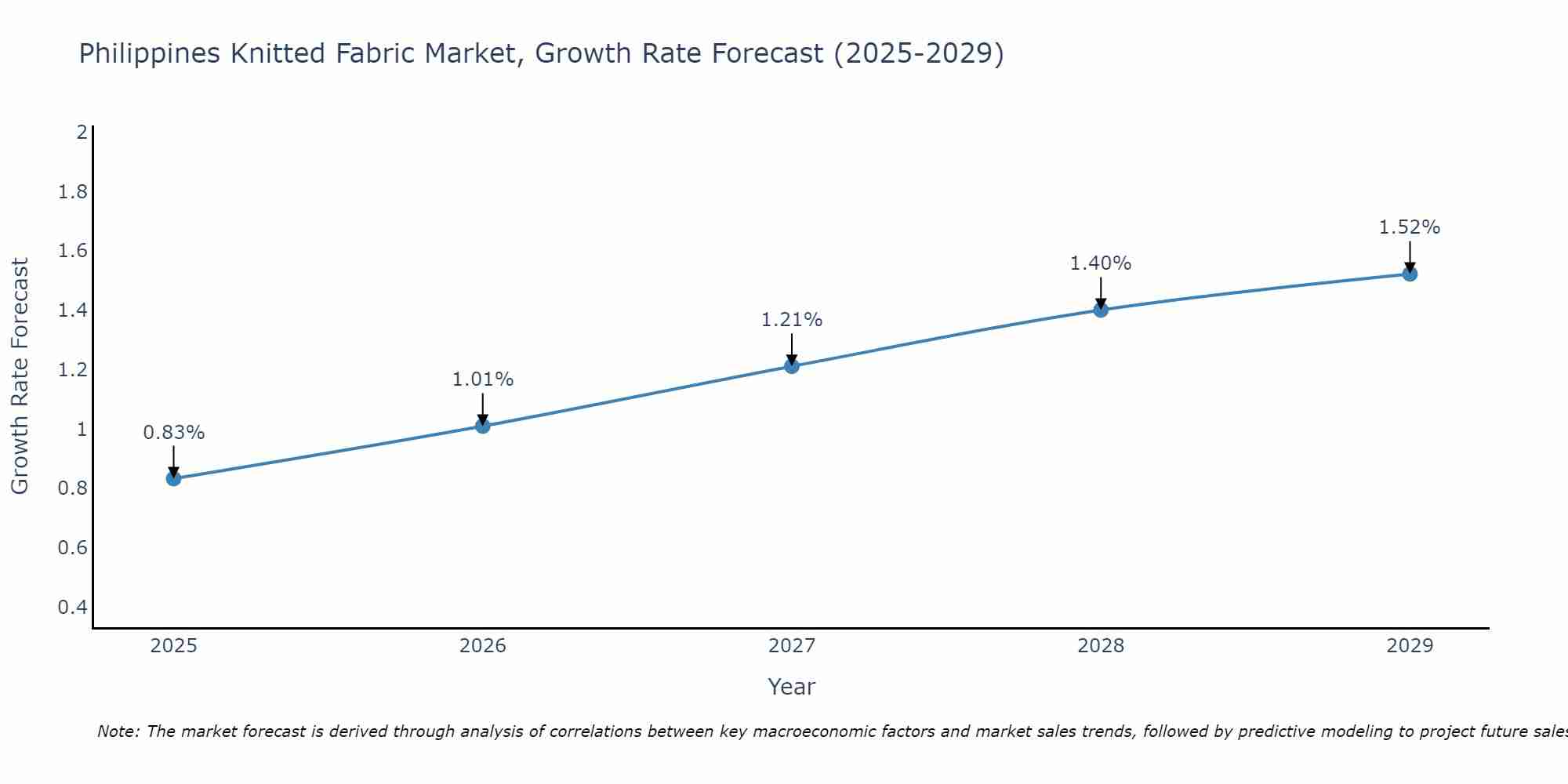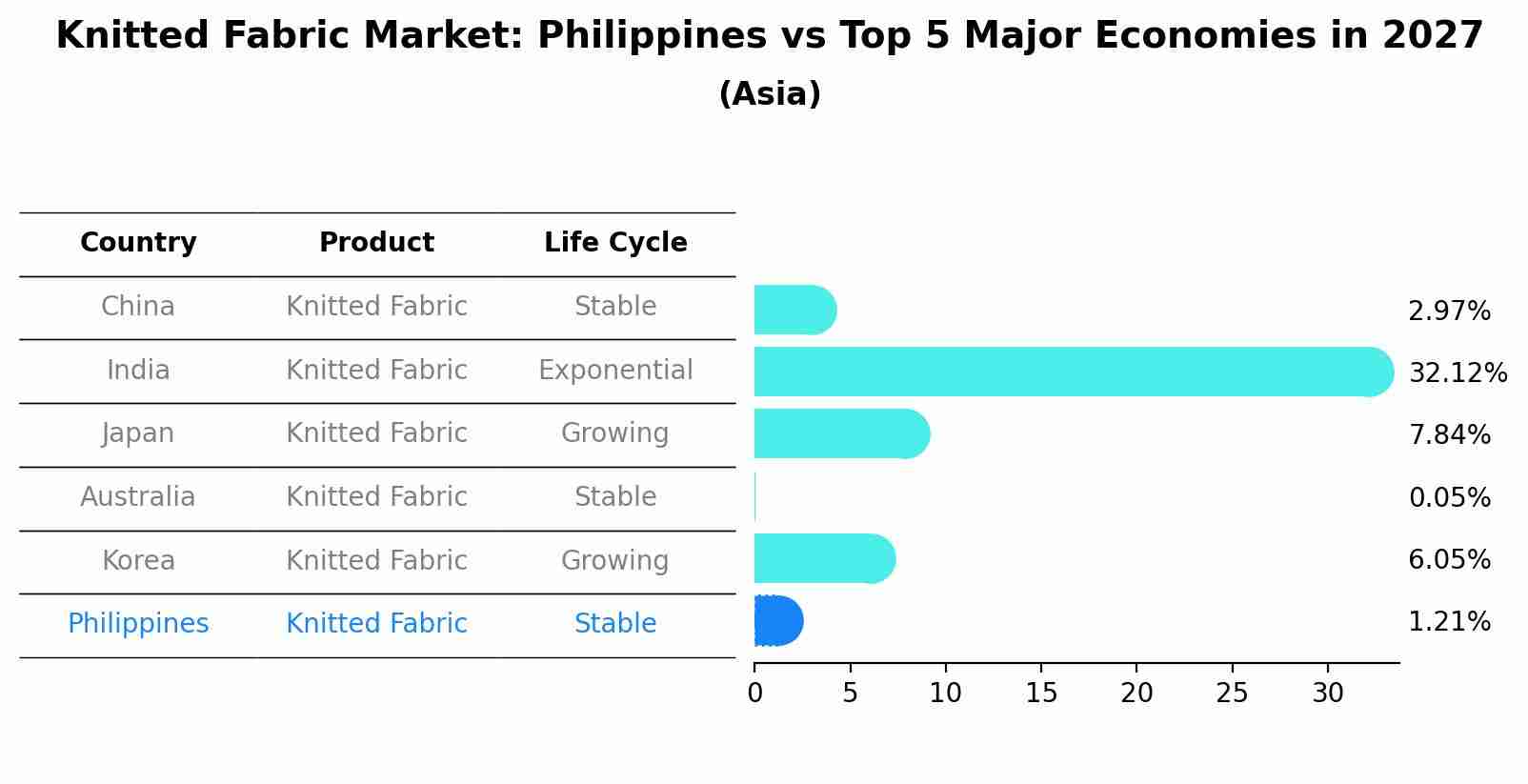Philippines Knitted Fabric Market (2025-2031) | Companies, Revenue, Industry, Outlook, Trends, Value, Growth, Share, Size, Forecast & Analysis
| Product Code: ETC036409 | Publication Date: Jul 2023 | Updated Date: Apr 2025 | Product Type: Report | |
| Publisher: 6Wresearch | No. of Pages: 70 | No. of Figures: 35 | No. of Tables: 5 | |
Philippines Knitted Fabric Market Size Growth Rate
The Philippines Knitted Fabric Market is likely to experience consistent growth rate gains over the period 2025 to 2029. The growth rate starts at 0.83% in 2025 and reaches 1.52% by 2029.

Knitted Fabric Market: Philippines vs Top 5 Major Economies in 2027 (Asia)
By 2027, the Knitted Fabric market in Philippines is anticipated to reach a growth rate of 1.21%, as part of an increasingly competitive Asia region, where China remains at the forefront, supported by India, Japan, Australia and South Korea, driving innovations and market adoption across sectors.

Philippines Knitted Fabric Market Synopsis
The Philippines knitted fabric market is forecasted to register a CAGR of 5.9% during the forecast period (2025-2031). Growing demand for activewear and athleisure apparel, increasing investments, and the changing lifestyle are some of the major factors driving the growth of this market in the country. Moreover, increasing disposable income has led to an increase in spending on fashionable garments which is further expected to drive the Philippine knitted fabric market over the projected time frame
Key Trends of The Market
With growing fitness awareness among people, there is increased demand for performance apparel like workout tights and sports bras that require breathable fabrics such as knits. This trend has enabled manufacturers to develop innovative products using advanced technology such as moisture wicking, UV protection, etc., which adds a high value proposition while choosing these garments. Additionally, several large companies have started investing heavily into research & development activities in order to introduce newer varieties of fabrics with improved features according to customer preferences. As a result, they are able to provide quality products at competitive prices that fulfil customer requirements better than before leading towards greater product sales within their respective markets.
Key Growth Drivers of the Market
An increase in disposable incomes over recent years has enabled people from all walks of life including middle class families also become more fashion conscious than ever before resulting in higher expenditure on fashionable clothing items made from knitted fabrics compared to other woven materials like twill or poplin etc.. This factor plays an important role in growing demand leading towards its popularity amongst consumers across different countries world wide including Philippines too due it its versatility & comfort level associated with it when worn against skin directly without any inner lining requirement thus making them ideal choice for summer wear collections especially short dresses & skirts etc
Key Challenges Faced by The Market
Manufacturers face challenges related with higher production costs while producing knitwear as compared other woven materials like twills or poplins due presence multiple processes involved during entire procedure along side yarn dyeing process prior actual knitting part itself thus adding additional burden onto pocket already burdened producers who generally tend pass cost benefit end consumer finally resulting lesser profits margins them eventually hampering overall sustainability industry long run if issue not addressed timely manner properly effectually eventually lead lower sales volumes both retailers well manufacturers themselves causing closure
Key Highlights of the Report:
- Philippines Knitted Fabric Market Outlook
- Market Size of Philippines Knitted Fabric Market, 2024
- Forecast of Philippines Knitted Fabric Market, 2031
- Historical Data and Forecast of Philippines Knitted Fabric Revenues & Volume for the Period 2021-2031
- Philippines Knitted Fabric Market Trend Evolution
- Philippines Knitted Fabric Market Drivers and Challenges
- Philippines Knitted Fabric Price Trends
- Philippines Knitted Fabric Porter's Five Forces
- Philippines Knitted Fabric Industry Life Cycle
- Historical Data and Forecast of Philippines Knitted Fabric Market Revenues & Volume By Construction Type for the Period 2021-2031
- Historical Data and Forecast of Philippines Knitted Fabric Market Revenues & Volume By Weft for the Period 2021-2031
- Historical Data and Forecast of Philippines Knitted Fabric Market Revenues & Volume By Wrap for the Period 2021-2031
- Historical Data and Forecast of Philippines Knitted Fabric Market Revenues & Volume By Fabrics Type for the Period 2021-2031
- Historical Data and Forecast of Philippines Knitted Fabric Market Revenues & Volume By Flat/Jersey for the Period 2021-2031
- Historical Data and Forecast of Philippines Knitted Fabric Market Revenues & Volume By Purl for the Period 2021-2031
- Historical Data and Forecast of Philippines Knitted Fabric Market Revenues & Volume By Rib Stitch for the Period 2021-2031
- Historical Data and Forecast of Philippines Knitted Fabric Market Revenues & Volume By Interlock for the Period 2021-2031
- Philippines Knitted Fabric Import Export Trade Statistics
- Market Opportunity Assessment By Construction Type
- Market Opportunity Assessment By Fabrics Type
- Philippines Knitted Fabric Top Companies Market Share
- Philippines Knitted Fabric Competitive Benchmarking By Technical and Operational Parameters
- Philippines Knitted Fabric Company Profiles
- Philippines Knitted Fabric Key Strategic Recommendations
Frequently Asked Questions About the Market Study (FAQs):
1 Executive Summary |
2 Introduction |
2.1 Key Highlights of the Report |
2.2 Report Description |
2.3 Market Scope & Segmentation |
2.4 Research Methodology |
2.5 Assumptions |
3 Philippines Knitted Fabric Market Overview |
3.1 Philippines Country Macro Economic Indicators |
3.2 Philippines Knitted Fabric Market Revenues & Volume, 2021 & 2031F |
3.3 Philippines Knitted Fabric Market - Industry Life Cycle |
3.4 Philippines Knitted Fabric Market - Porter's Five Forces |
3.5 Philippines Knitted Fabric Market Revenues & Volume Share, By Construction Type, 2021 & 2031F |
3.6 Philippines Knitted Fabric Market Revenues & Volume Share, By Fabrics Type, 2021 & 2031F |
4 Philippines Knitted Fabric Market Dynamics |
4.1 Impact Analysis |
4.2 Market Drivers |
4.3 Market Restraints |
5 Philippines Knitted Fabric Market Trends |
6 Philippines Knitted Fabric Market, By Types |
6.1 Philippines Knitted Fabric Market, By Construction Type |
6.1.1 Overview and Analysis |
6.1.2 Philippines Knitted Fabric Market Revenues & Volume, By Construction Type, 2021-2031F |
6.1.3 Philippines Knitted Fabric Market Revenues & Volume, By Weft , 2021-2031F |
6.1.4 Philippines Knitted Fabric Market Revenues & Volume, By Wrap, 2021-2031F |
6.2 Philippines Knitted Fabric Market, By Fabrics Type |
6.2.1 Overview and Analysis |
6.2.2 Philippines Knitted Fabric Market Revenues & Volume, By Flat/Jersey, 2021-2031F |
6.2.3 Philippines Knitted Fabric Market Revenues & Volume, By Purl , 2021-2031F |
6.2.4 Philippines Knitted Fabric Market Revenues & Volume, By Rib Stitch, 2021-2031F |
6.2.5 Philippines Knitted Fabric Market Revenues & Volume, By Interlock , 2021-2031F |
7 Philippines Knitted Fabric Market Import-Export Trade Statistics |
7.1 Philippines Knitted Fabric Market Export to Major Countries |
7.2 Philippines Knitted Fabric Market Imports from Major Countries |
8 Philippines Knitted Fabric Market Key Performance Indicators |
9 Philippines Knitted Fabric Market - Opportunity Assessment |
9.1 Philippines Knitted Fabric Market Opportunity Assessment, By Construction Type, 2021 & 2031F |
9.2 Philippines Knitted Fabric Market Opportunity Assessment, By Fabrics Type, 2021 & 2031F |
10 Philippines Knitted Fabric Market - Competitive Landscape |
10.1 Philippines Knitted Fabric Market Revenue Share, By Companies, 2024 |
10.2 Philippines Knitted Fabric Market Competitive Benchmarking, By Operating and Technical Parameters |
11 Company Profiles |
12 Recommendations |
13 Disclaimer |
- Single User License$ 1,995
- Department License$ 2,400
- Site License$ 3,120
- Global License$ 3,795
Search
Related Reports
- ASEAN Bearings Market (2025-2031) | Strategy, Consumer Insights, Analysis, Investment Trends, Opportunities, Growth, Size, Share, Industry, Revenue, Segments, Value, Segmentation, Supply, Forecast, Restraints, Outlook, Competition, Drivers, Trends, Demand, Pricing Analysis, Competitive, Strategic Insights, Companies, Challenges
- Europe Flooring Market (2025-2031) | Outlook, Share, Industry, Trends, Forecast, Companies, Revenue, Size, Analysis, Growth & Value
- Saudi Arabia Manlift Market (2025-2031) | Outlook, Size, Growth, Trends, Companies, Industry, Revenue, Value, Share, Forecast & Analysis
- Uganda Excavator, Crane, and Wheel Loaders Market (2025-2031) | Strategy, Consumer Insights, Analysis, Investment Trends, Opportunities, Growth, Size, Share, Industry, Revenue, Segments, Value, Segmentation, Supply, Forecast, Restraints, Outlook, Competition, Drivers, Trends, Demand, Pricing Analysis, Competitive, Strategic Insights, Companies, Challenges
- Rwanda Excavator, Crane, and Wheel Loaders Market (2025-2031) | Strategy, Consumer Insights, Analysis, Investment Trends, Opportunities, Growth, Size, Share, Industry, Revenue, Segments, Value, Segmentation, Supply, Forecast, Restraints, Outlook, Competition, Drivers, Trends, Demand, Pricing Analysis, Competitive, Strategic Insights, Companies, Challenges
- Kenya Excavator, Crane, and Wheel Loaders Market (2025-2031) | Strategy, Consumer Insights, Analysis, Investment Trends, Opportunities, Growth, Size, Share, Industry, Revenue, Segments, Value, Segmentation, Supply, Forecast, Restraints, Outlook, Competition, Drivers, Trends, Demand, Pricing Analysis, Competitive, Strategic Insights, Companies, Challenges
- Angola Excavator, Crane, and Wheel Loaders Market (2025-2031) | Strategy, Consumer Insights, Analysis, Investment Trends, Opportunities, Growth, Size, Share, Industry, Revenue, Segments, Value, Segmentation, Supply, Forecast, Restraints, Outlook, Competition, Drivers, Trends, Demand, Pricing Analysis, Competitive, Strategic Insights, Companies, Challenges
- Israel Intelligent Transport System Market (2025-2031) | Strategy, Consumer Insights, Analysis, Investment Trends, Opportunities, Growth, Size, Share, Industry, Revenue, Segments, Value, Segmentation, Supply, Forecast, Restraints, Outlook, Competition, Drivers, Trends, Demand, Pricing Analysis, Competitive, Strategic Insights, Companies, Challenges
- Uganda Precast and Aggregate Market (2025-2031) | Strategy, Consumer Insights, Analysis, Investment Trends, Opportunities, Growth, Size, Share, Industry, Revenue, Segments, Value, Segmentation, Supply, Forecast, Restraints, Outlook, Competition, Drivers, Trends, Demand, Pricing Analysis, Competitive, Strategic Insights, Companies, Challenges
- Australia IT Asset Disposal Market (2025-2031) | Strategy, Consumer Insights, Analysis, Investment Trends, Opportunities, Growth, Size, Share, Industry, Revenue, Segments, Value, Segmentation, Supply, Forecast, Restraints, Outlook, Competition, Drivers, Trends, Demand, Pricing Analysis, Competitive, Strategic Insights, Companies, Challenges
Industry Events and Analyst Meet
Our Clients
Whitepaper
- Middle East & Africa Commercial Security Market Click here to view more.
- Middle East & Africa Fire Safety Systems & Equipment Market Click here to view more.
- GCC Drone Market Click here to view more.
- Middle East Lighting Fixture Market Click here to view more.
- GCC Physical & Perimeter Security Market Click here to view more.
6WResearch In News
- Doha a strategic location for EV manufacturing hub: IPA Qatar
- Demand for luxury TVs surging in the GCC, says Samsung
- Empowering Growth: The Thriving Journey of Bangladesh’s Cable Industry
- Demand for luxury TVs surging in the GCC, says Samsung
- Video call with a traditional healer? Once unthinkable, it’s now common in South Africa
- Intelligent Buildings To Smooth GCC’s Path To Net Zero













